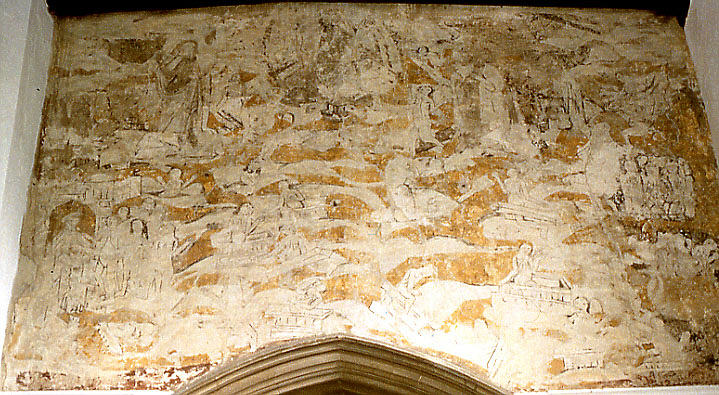Marston Moreteyne, Bedfordshire (†St Albans) C.15/16
Doom

This very large Doom (16x11′) is also one of the latest in medieval England. A local will, made by a man called William Wodill, makes mention of bequests for a Rood-light and the painting of the ‘loft and the Dome’. The will was made on 20th November, 1505, and proved on 28th January, 1505/6. It almost certainly refers to this painting.
The first impression given is of yellow and white shapes chasing each other across the chancel arch wall, and the painting initially strikes the eye as completely abstract. For some reason, the painter has restricted himself to a very limited palette – yellow ochre, white and black with only a very few touches of red. But in fact there is a wealth of detail here, much of it unfortunately blurred and obscure now.
Some things can be made out, though. At the top centre, Christ once sat on a rainbow painted within a sphere – the rainbow and the circular outline of the sphere are still just discernible. At the left is the Virgin, her hands held up palms outward in entreaty. St John the Baptist, less easy to make out, is in the corresponding position at the right. He is a significantly smaller figure than the Virgin.
Slightly clearer at the bottom left, St Peter welcomes a group of naked saved souls. He stands in front of a painted building with an arched doorway. At the bottom right, a large pot-bellied cauldron is crammed with damned souls, presumably boiling. Above this, but almost impossible to see now, is the Mouth of Hell. Around these main figures in the drama, the dead rise out of a selection of tombs, many of them table-tombs of at type becoming popular among the wealthy from the 14th century onwards (there are a few 14th & 15th century examples left in English churchyards). These resurrected dead and their sarcophagi, especially near the bottom of the painting, are the clearest details in the painting – one figure, just above the apex of the chancel arch and slightly to its left, leans back, elbow on tomb, her other arm held up to shield her(?) eyes from the dazzling light above.
This is not a sophisticated piece of work – it is in fact quite crudely painted – but as Clive Rouse points out in a short article reproduced in the booklet in the church, the psychological impact of the huge, active, scene on the congregation below it must have been very considerable.